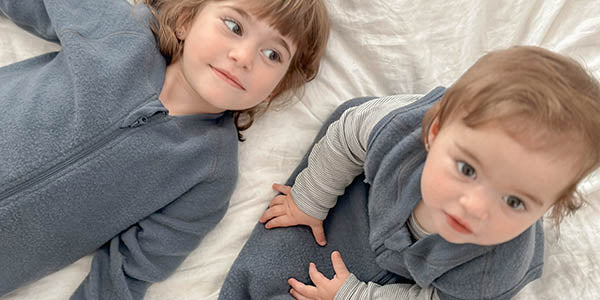
Merino wool sleeping bag and Tog rating
Think back to a time when you wore a jumper knitted with synthetic fibres and how clammy and sweaty you felt. Or the cotton quilt that couldn’t keep you warm enough. Then think about what fibres you’re putting on your children to go to bed and sleep comfortably. There’s often a very good reason they wake, even if you think you’ve chosen sleepwear with the right tog rating.
A Merino sleeping bag, on the other hand, has many natural qualities for regulating body temperature, which is why there’s no need for a tog rating. It provides exceptional warmth, yet is cool in warmer weather, it’s softer than regular wool, and it’s 100% natural.
Read more about ‘Why Merino Wool?’.
What is a tog rating?
TOG is the acronym for Thermal Overall Grade. A tog is the rating a sleep garment is given to indicate the amount of warmth it provides – the higher the rating, the warmer the garment is.
Understandably, selecting the right baby sleeping bag togs is critical for parents to ensure their child doesn’t overheat and increase the risk of SIDS (Sudden Infant Death Syndrome). Through our time producing sleepwear for babies and young children, this is most certainly one of the top concerns and anxieties for parents. It’s the reason why Merino wool sleeping bags provide peace of mind, even though they don’t have a tog rating.
Why don’t Merino sleeping bags have a tog rating?
The reason Merino sleeping bags don’t have a tog rating is not that they are inferior to the ones that do; in fact, it’s quite the opposite. It’s the natural and unique qualities of Merino wool that take away the need to rate Merino sleeping bags in the first place.
Where a cotton-blend sleeping bag may only provide a baby warmth to a certain degree and a synthetic fibre sleeping bag, although having the ability to retain warmth, increases the risk of overheating because the fibres are unbreathable, Merino wool solves both of these problems. It, therefore, does not need to be Tog rated. A Merino baby sleeping bag creates a personal temperature-controlled environment. Merino wool regulates the baby’s temperature to suit the outside environment. This regulation drastically lowers the risk of overheating in young children and encourages safe sleep. Unlike adults, babies and young children have difficulty regulating their body temperature and so Merino wool provides them with a little help.
In many parts of Australia, it can be so tricky to dress children for sleep. They can go to bed early in the evening when it’s quite warm, wearing a 1.0 tog cotton sleeping bag. Yet, during the early morning, the temperature can drop right down to a level where a baby would need a 2.5 tog. And then guess what happens? They wake because, in the case of cotton sleepwear, they’re uncomfortable because they’re not warm enough. With synthetic fibres, the most common reason for night time waking is because they feel uncomfortable, hot and clammy.
A Merino wool baby sleeping bag, on the other hand, has natural fibres that regulate the body temperature throughout the fluctuations. While regulating, Merino wool keeps the body temperature stable which leads to fewer wake-ups. A Merino wool sleeping bag is more versatile than a traditional TOG rated sleeping bag. Children can use one sleeping bag over a broader range of temperatures.
Merino wool’s natural ability to regulate temperature
It’s common for people to immediately relate wool to something you only wear to keep warm when, in fact, you can use it during most months of the year.
Merino sleeping bags are the most unique sleeping bag on the market because the magic starts with the micro-environment the wool creates around the body. But how does the magic happen?
It’s all in the fibres
As your child’s body gets warmer, the wool transfers this extra heat and any sweat along the fibres and releases it into the cooler and drier outside environment using evaporation. This process is called moisture wicking. When the temperature is cold, the wool retains the warmth in the fibres.
Wool fibres love moisture and naturally absorb it. They can absorb large amounts of moisture vapour, even before it turns into sweat. Under the microscope, a single wool fibre is complex, and a reflection of the inherent superpowers it has.
Why you should forget tog rating and opt for Merino instead
What would it be like for you if your child not only fell asleep quicker, but they had a deeper sleep with less night waking? Associate Professor Chin Moi Chow from The University of Sydney headed a study on how sleepwear fibre can impact sleep quality. The study found that people using wool sleepwear fell asleep quicker, and they had deeper, less fragmented sleep. Wow!
In a study conducted by the Cambridge Maternity Hospital in 1979, Scott and Richards revealed that babies sleeping on Merino settled more quickly, cried less, fed better and gained weight faster when they slept on wool as opposed to cotton. The product comparison between a baby Merino sleeping bag and polyester baby sleep product pointed out one key difference. The Merino product had much higher moisture vapour absorption. This sophisticated level of ‘breathability’ in the Merino system means it’s better at transferring moisture away from the child. At the same time, it reduces convective heat loss and mitigates the chilling effect of drafts. What a great feeling to be able to worry less about whether your baby is too hot or too cold?
Nature is quite remarkable. Our wool is 100% Australian Merino, and when you think of the sheep living in the fluctuating Australian environment, they survive and thrive thanks to wearing their own little micro-environments, living comfortably and consuming nothing but water and grass. Merino wool isn’t about tog ratings; it’s about the course of nature.
